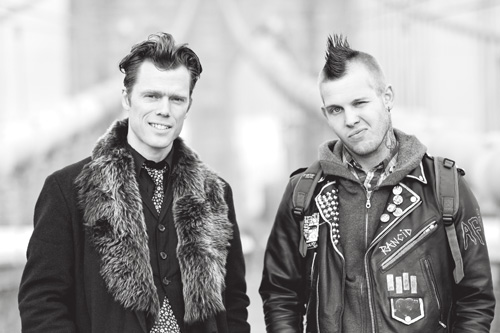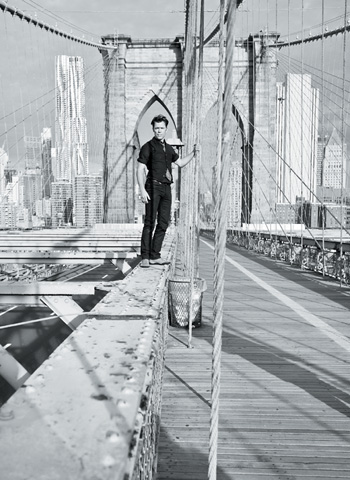26. Order Within Chaos

The wood planks of the Brooklyn Bridge bike and walking path are worn smooth from the constant traffic of exercise fanatics. On this fall morning the hustle and bustle was intense. Yet, musician and Broadway performer Jared Mason was poised and engaged. Through patience and careful composition it looks as if no one else was there, which creates a simpler, stronger picture.
Canon 5DMii, 85mm lens, f/3.5
GROWING UP in a relatively small and sleepy town, it was always exciting to go to “The City,” as it was affectionately known. As far as we were concerned, it was the one and only city, the city that captivated our hearts. Crossing the Bay Bridge and arriving in San Francisco was an experience that was expectant and full of hope.
The city was bursting with life and there were endless adventures waiting. With crooked streets, cable cars, and the hustle and bustle of it all, it was impossible not to encounter something new. Even with a charming and quaint city like San Francisco, when you first arrive it can seem like a confusing mess.
The clatter of the cable car tracks, the intense aroma of boiling crab, the honking cars, and the buildings pointing toward the skies—to pick up on the rhythm of such a place takes time. But once you do, this cacophony becomes a song, a familiar and nostalgic tune. And this reminds us that there is order within the chaos and the tumult drives the beat home.
Finding the Moments in Between
As a photographer, the calm found amidst such disarray is what catches our eye. Those moments in between, like the silence between notes, is where your heart lingers. Yet finding the quiet in the middle of noise is not an easy task. Rather than fighting the crowds and going against the tide, finding silence and peace requires a more amicable approach.
Bob Dylan once wrote, “Chaos is a friend of mine,” and this is the kind of portrait that I want you to make. Rather than retreating to a quiet, soft location like a studio or neighborhood park, go out into the eye of the storm and strive to capture something that resonates with that mood. Become a friend of the busyness of it all. Feed off the energy of the crowd and simultaneously keep your eyes open for the simple beat.

During the Brooklyn Bridge shoot, I noticed this man walking down the path. I asked if he’d mind joining us for a photo. The visual juxtaposition of these two New Yorkers is fabulous.
Canon 5DMii, 85mm lens, f/2
Exercise: Streetscape Portrait
Mario Andretti once said, “If everything is under control you are not going fast enough.” This exercise requires that you put the pedal to the metal and step out of your photographic comfort zone. Begin by choosing a subject who really excels at what he does.
Step 1 Choose a Strong Subject
Rather than photographing someone you are comfortable with, why not try for someone who is considered big? For example, instead of photographing a colleague at work, create a portrait of the CEO. Instead of a soccer player in your local league, why not the captain of a professional team?
Strive to photograph someone whose talent you admire. While it might be a challenge to get access to that person, don’t give up. Keep trying until you find someone whom you respect and who is well above your level at whatever his area of expertise may be.
Step 2 Storyboard
Next, choose a location that is not serene and secluded but one that is busy and vibrant. For an extra challenge, find a setting that is iconic and well known. Be sure to pick a location that has some relevance to the subject and to the story that you want to tell.
Tips
Good portraiture requires great concentration, connection, and resolve. Stay focused and strong.
Ask your subject to follow your lead and keep him moving from one spot to the next.
Don’t skip the storyboard step; it’s important to visualize your shoot with your subject.
Set the tone for remaining engaged even amid the distracting noise. Keep your subject engaged with strong eye contact and keen conversation.
Before the shoot, take 20 minutes and create at least five storyboard ideas for the shoot and sketch them out. Do this as an attempt to visualize what type of pictures you want to create. Even if you don’t consider yourself good at drawing, make sure to include this step. Add simple descriptive words to each one that clarify the intent of each shot. (To view the story boards for my Brooklyn Bridge shoot, visit 30peoplepictures.com/storyboard.)
Step 3 On Location
Arrive at the location 20 minutes early in order to walk around. Be on the lookout for different angles and perspectives and take a few shots. Continue to warm up your senses in the same way a runner stretches or jogs before a big race. Run a few visual laps and get familiar with the scene.
Exercise Details
Goal: 20 portraits, with 5 that follow your visualized storyboard ideas. Tools: Camera; one wide-angle lens and one normal- to telephoto-focal-length lens. Light: Natural or available light. Location: Busy outdoor scene. Themes: Finding order within chaos and stepping out of your comfort zone. Duration: 45 minutes.
Step 4 Meet and Greet
While wearing your camera on your shoulder, meet the subject with gusto and grace. Give a firm handshake and express your gratitude and enthusiasm for the photo shoot. Ask him some initial questions and really listen to what he says. Make sure your body posture is engaged and your eyes focused, too. Spend about five minutes on this step.
Step 5 The Shoot
Next, fire off a few shots. This will break the ice early and create a more natural flow. Walk with your subject to the center of the scene and start taking pictures amid the chaos for 20 minutes. Don’t let the busyness slow you down. Think like a race car driver and stay focused on the checkered finish flag. Remember your goal is to capture each of your storyboard ideas.
While working with the subject in various spots, create 20 photographs that are resonant and full of peace. In other words, create pictures that make the complexity of the environment fade away.
Step 6 Wrap and Reflection
At the end of the shoot, thank your subject for his time. Provide him with a small thank-you gift and say good-bye. Before leaving the location, open up your storyboard sketches and reflect to see if you actually got each shot. Then while the location is still fresh, sketch out any shots that you may have missed. Ask yourself how you could have improved working within such a complex location. Give yourself some feedback and write notes on how you want to improve next time.
OPPOSITE This frame seems like it could have been taken yesterday or perhaps long ago. Jared is confident, alive, and anchored with one hand. And he is perfectly framed by the bridge and cityscape in the scene.
Canon 5DMii, 16–35mm lens, f/2.8
“Photography is a response that has to do with the momentary recognition of things.”
—Joel Meyerowitz

